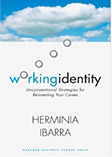If you’re interested in the connection between story and career, Herminia Ibarra is a name you need to know.
I first encountered her well-known Harvard Business Review article (Ibarra, H. & Lineback, L.K. [2005] “What’s Your Story?” Harvard Business Review, January, 83 [1]: 64-71) during my dissertation research and referred to it often.
H. & Lineback, L.K. [2005] “What’s Your Story?” Harvard Business Review, January, 83 [1]: 64-71) during my dissertation research and referred to it often.
But it wasn’t until I began soliciting nominations for a list of indispensable career books for the 15th anniversary of A Storied Career’s parent, Quintessential Careers, that I learned of Ibarra’s 2003 book, Working Identity: Unconventional Strategies for Reinventing Your Career.
Ibarra presents a new model for career change in which knowing what kind of career change we want is the result of doing and experimenting — as opposed to the common view that we must know what we want to do before we can make a change.
Story and narrative, Ibarra says, play a role in this career-change experimentation:
Throughout a career transition, the narratives we craft to describe why we are changing (and what remains the same) also help us try on possibilities.
She describes a case study in which the subject’s attempts to explain her transition were often clumsy — but the more she told her story, the more sharply defined it became, and the more excited she became about it. “Each retelling informed her evolving story,” Ibarra explains.
Later in the book, Ibarra notes:
People devote considerable energy to developing their stories — what key experiences marked their path; what meanings they attribute to those experiences; and more importantly what common thread links old and new.
Ultimately, though, our stories “never reflect objective reality,” Ibarra asserts, which is “why revising our stories is a fundamental tool for reinventing ourselves.” Further:
One of the central identity problems that has to be worked out during a career transition is deciding on a story that links the old and new self. Until that is solved, the external audience to whom we are selling our reinvention remains dubious, and we too feel unsettled and uncertain of our own identity. To be compelling, the story must explain why we must reinvent ourselves, who we are becoming, and how we will get there.
 Although others view us as unfocused before we fully have a story, retelling and rehearsing the story “until it comes out just right” results not only in a polished story but in a narrative that can inform the next step.
Although others view us as unfocused before we fully have a story, retelling and rehearsing the story “until it comes out just right” results not only in a polished story but in a narrative that can inform the next step.
Indeed, Ibarra lists story-retelling as one of nine unconventional strategies for career change. “Take advantage of whatever life sends your way to revise, or at least reconsider your story,” she says. “Practice telling it different ways to different people, in much the same way you would revise a resume and cover letter for different jobs. But don’t just tell the story to a friendly audience; try it out on skeptics. And don’t be disturbed when the story changes along the way.”
Through discovering Ibarra’s book and Web site, I also learned of an academic paper she authored that I look forward to reading:
Ibarra, H. & Barbulescu, R. (2010) “Identity as Narrative: Prevalence, Effectiveness, and Consequences of Narrative Identity Work in Macro Work Role Transitions.” Academy of Management Review, January, 35 (1): 135-154.
You can access it through library or university databases.
